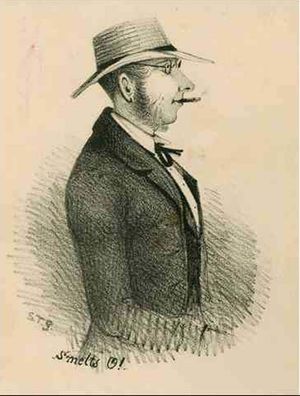Difference between revisions of "John Brown"
WikiadminBot (talk | contribs) (Bot: Automated import of articles *** existing text overwritten ***) |
WikiadminBot (talk | contribs) (Bot: Automated import of articles *** existing text overwritten ***) |
||
| Line 1: | Line 1: | ||
| + | '''John Brown''' | ||
{{Infobox rai-fellow | {{Infobox rai-fellow | ||
| first_name = John | | first_name = John | ||
| Line 5: | Line 6: | ||
| honorific_suffix = | | honorific_suffix = | ||
| image = File:Brown,_John.jpg | | image = File:Brown,_John.jpg | ||
| − | | birth_date = | + | | birth_date = 1797 |
| − | | death_date = | + | | death_date = 1861 |
| − | | address = | + | | address = |
| occupation = | | occupation = | ||
| elected_ESL = 1844.04.09 | | elected_ESL = 1844.04.09 | ||
| Line 23: | Line 24: | ||
=== House Notes === | === House Notes === | ||
| − | + | Father of John Allen Brown | |
=== Notes From Elsewhere === | === Notes From Elsewhere === | ||
| − | + | Brown was born in Dover in 1797, and served for some time as a midshipman in the East India Company's service. In March 1819 he was forced to leave the sea because of poor eyesight. He went on to become a diamond merchant and made a fortune.[1]<br />He took a keen interest in geographical exploration, and became a fellow of the Geographical Society in 1837. He presented a portrait of his friend James Weddell (the explorer of the Antarctic) to the society in 1839, with a letter advocating further expeditions. In 1843 Brown obtained a pension for Weddell's widow from Sir Robert Peel. He was a founder of the Ethnological Society of London in the same year<br />Brown became a noted advocate of expeditions in search of Sir John Franklin. He defined the area which the expedition was ultimately found to have reached, but was not attended to at the time. He published The North-west Passage and the Plans for the Search for Sir John Franklin: a review (1860). He was complimented on this work by Alexander von Humboldt. Brown made large collections illustrative of Arctic adventure.[1]<br />His wife predeceased him, and he died in 1861, leaving three sons and two daughters. | |
== Publications == | == Publications == | ||
=== External Publications === | === External Publications === | ||
| − | + | The North West Passage | |
=== House Publications === | === House Publications === | ||
Revision as of 09:23, 20 January 2021
John Brown
| John Brown | |||||||||
|---|---|---|---|---|---|---|---|---|---|
 | |||||||||
| Born | 1797 | ||||||||
| Died | 1861 | ||||||||
| |||||||||
Contents
Notes
Office Notes
House Notes
Father of John Allen Brown
Notes From Elsewhere
Brown was born in Dover in 1797, and served for some time as a midshipman in the East India Company's service. In March 1819 he was forced to leave the sea because of poor eyesight. He went on to become a diamond merchant and made a fortune.[1]
He took a keen interest in geographical exploration, and became a fellow of the Geographical Society in 1837. He presented a portrait of his friend James Weddell (the explorer of the Antarctic) to the society in 1839, with a letter advocating further expeditions. In 1843 Brown obtained a pension for Weddell's widow from Sir Robert Peel. He was a founder of the Ethnological Society of London in the same year
Brown became a noted advocate of expeditions in search of Sir John Franklin. He defined the area which the expedition was ultimately found to have reached, but was not attended to at the time. He published The North-west Passage and the Plans for the Search for Sir John Franklin: a review (1860). He was complimented on this work by Alexander von Humboldt. Brown made large collections illustrative of Arctic adventure.[1]
His wife predeceased him, and he died in 1861, leaving three sons and two daughters.
Publications
External Publications
The North West Passage